ZZ plants can develop wrinkled stems because of overwatering where the rhizome and roots can become damaged. Wrinkled stems on ZZ plants can also be caused by underwatering, too much sun exposure, old and hydrophobic soil or if they are replacing old stems.
This article will explore all of the reasons why ZZ plants develop wrinkled stems and what you can do to solve this problem.

What causes wrinkled stems on ZZ plants | Top 5 Causes
Wrinkled stems on ZZ plant can be caused by over or underwatering, dry soil caused by too much sun or an old hydrophobic potting mix. Old stems on ZZ plant will naturally dry off and become wrinkled and can be trimmed off to tidy up the plant.
This article will explore the top 5 causes of wrinkled stems on ZZ plants and what you can do to solve each one.
Top causes of wrinkled stems on ZZ plants
ZZ plant stems can wrinkle for 5 different reasons. Have a look through to see which one might be affecting your plant at home.
1. Overwatering
Overwatering is the top cause of ZZ plant stems wrinkling. ZZ plants grow from rhizomes that look like small potatoes. These hold water and make the ZZ plant prone to overwatering. This can cause stem damage, which can cause them to wrinkle and bend.
You may also notice black or brown spots on the stems. Too much water can also be matched with yellowing leaves as nutrients are washed out of the soil. Overwatered soil can also lack oxygen and can lead to root rot and damage.
Overwatering can happen if the plant is watered more than once per month. If water sits at the bottom of the pot tray or a self-watering pot the plant can absorb too much water. You will notice the soil looks damp and may even have mold growth on the surface. This could be white or green.
Stems can also become long and leggy if the plant is overwatered. For more on this, check out my previous article, How to fix a leggy ZZ plant | 5 Easy Steps
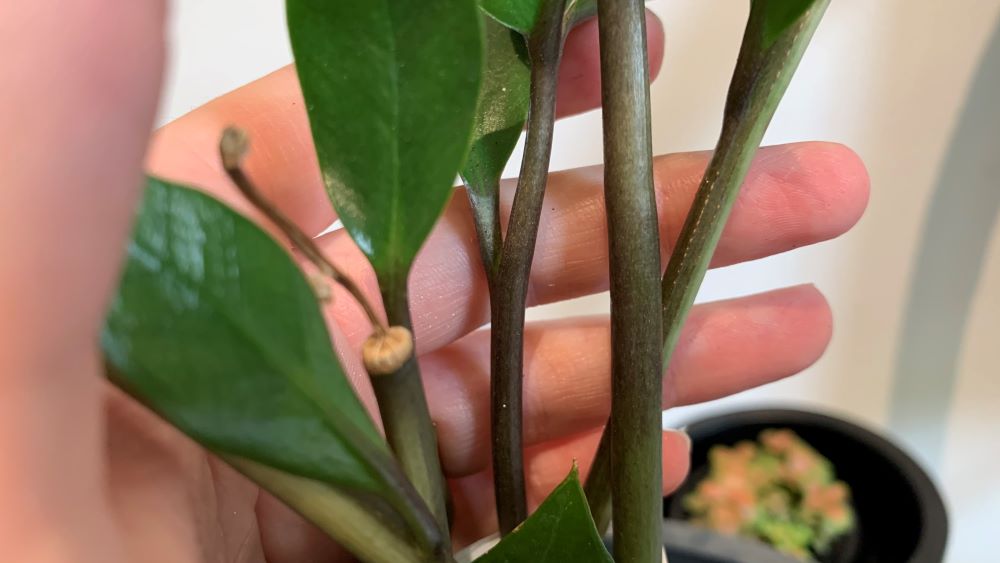
2. Underwatering
Underwatering can also cause your ZZ plant stems to become wrinkled. If you notice that the soil looks dry on the surface, is clumping together or has been in the pot for more than 2 years it could lead to underwatering.
It is ideal to water ZZ plants once per month but any less than that could lead to your ZZ plant dry out too much. The stems will become wrinkled, dry and even brown and can bend over.
3. Too much sun
ZZ plant stems can become damaged by too much direct sunlight. ZZ plants love deep shade so if they are positioned inside in a spot that gets direct morning or afternoon sun they can suffer from burn. If they are placed near a window the radiant heat can be too much causing leaf and stem damaged and wrinkling.
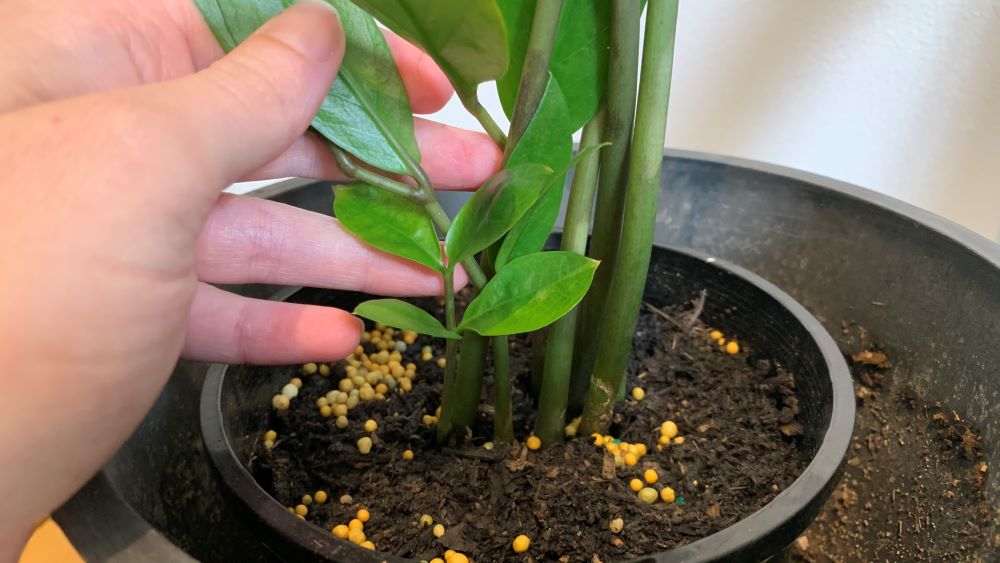
4. Old and damaged soil
Wrinkled stems on ZZ plants can be caused by old and damaged soil. Old soil can develop a coating on the outside of the particles causing it to become hydrophobic and it won’t be able to absorb water. Old soil can also drop in level, become compact and anerobic.
The ZZ plant roots will struggle to absorb water and nutrients and the plant can suffer. The leaves, stems and rhizomes can become damaged.
5. Old stems
Old stems on ZZ plants will naturally be replaced with new ones. The old stems will dry, wrinkle and will be replaced with new sprouts. These old stems might make you think there is something wrong with your ZZ plant but if they are the smaller outer stems, this is likely just to be the natural process the plant will go through.
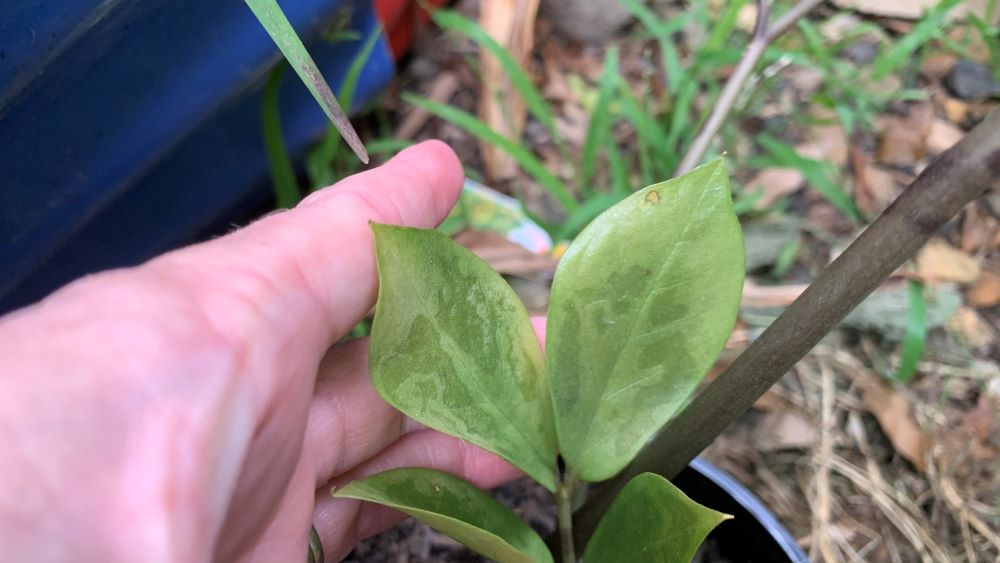
How to fix wrinkled stems on ZZ plants
Here are my top 5 tips to fix wrinkled stems on ZZ plants at home. These will help your plant to recover from any problems that have caused the stem damage.
1. Repot ZZ plants with old soil
Repotting a ZZ plant that has been in the same pot for 2 years or more is a great way to revive and help to repair the stems. If the pot feels firm or if you see roots coming out the bottom it is usually a sign the plant is ready for fresh soil.
Tip the plant on its side outdoors and gently remove it from the pot. Move the plant into a new pot that is 1-2 inches wider and deeper than the original. Add new, good quality potting soil to the base of the pot and fill the outer edges with the new soil to feed the plant. Settle the soil in by deep watering the plant and let it drain well before bringing it back indoors.
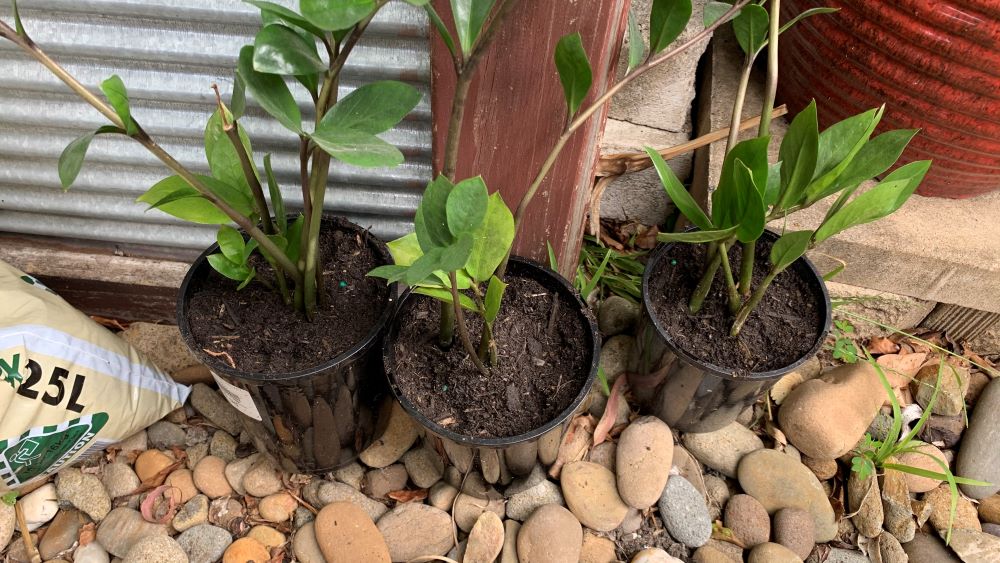
2. Reduce your watering
If you have discovered that you have been adding too much water to your ZZ plant it is time to reduce the amount you are adding. The ideal amount usually is around once every 4 weeks. I like to take the inner pot out and place it in a sink or outdoors. I will then thoroughly wet the soil all across the surface.
I will leave it to drain for around 10 minutes before bringing it back inside to sit inside the indoor pot.
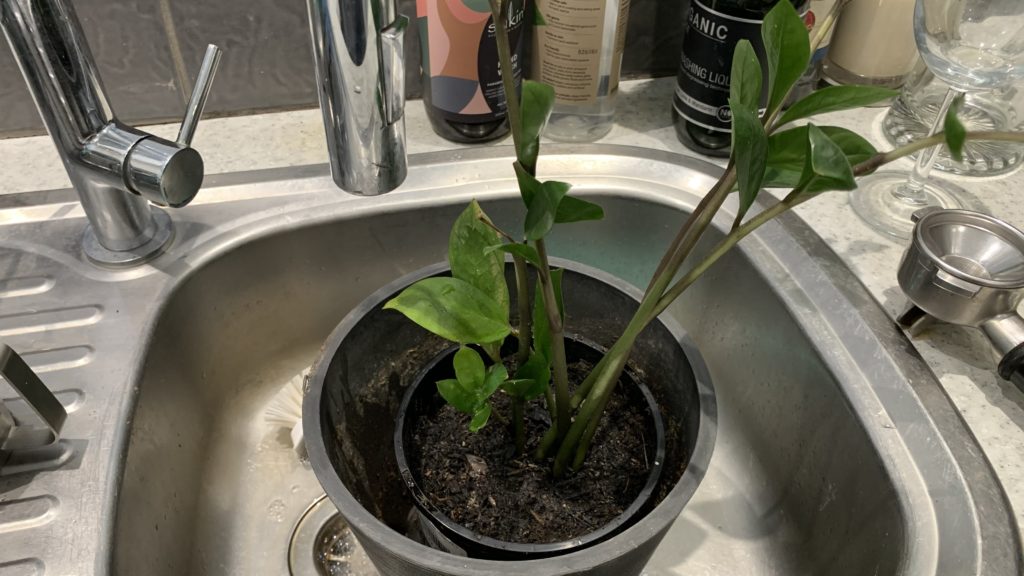
3. Deep soak a dry plant
To fix an underwatered ZZ plant, deep soaking is a great method, If you find that your soil is dry but you don’t need to repot your plant place the whole pot in a bucket of water. I like to add a dash of seaweed solution to help the roots to recover and leave it there to soak for 10 minutes.
This process will thoroughly wet the soil and help a very dry plant and hydrophobic soil to rehydrate. Always allow it to drain well before bringing it back indoors. Water regularly every 4 weeks and your plant should stay healthy and happy.
4. Move the plant to a space with filtered light
Choose a position of your ZZ plant that is out of direct sun but still gets filtered light throughout the day. While ZZ plants can tolerate low amounts of light, they will grow well if they get some light throughout the day.

5. Divide your rhizomes on a root bound plant
For ZZ plants that are filling out the pot or have become root bound it can be a great idea to divide them. Tip the plant out and gently pull apart the rhizomes to make new plants. Try to divide the plant to naturally come apart where the rhizomes are no longer attached.
For more on dividing ZZ plant rhizomes, check out my previous article here: How to divide a ZZ plant | Easy 8 Step Guide
ZZ plants with wrinkled stems | Summary
Wrinkled stems on ZZ plants are often caused by overwatering or underwatering. Old stems will wrinkle and turn yellow and brown naturally so you can simply remove them using sharp secateurs. Snip them off ½ an inch above the soil level. The end will naturally develop a callous and a new sprout will usually grow in spring.
I am an accredited practicing dietitian, experienced gardener and a dedicated cook. I love writing and sharing my experience so you can learn from my successes and mistakes.
